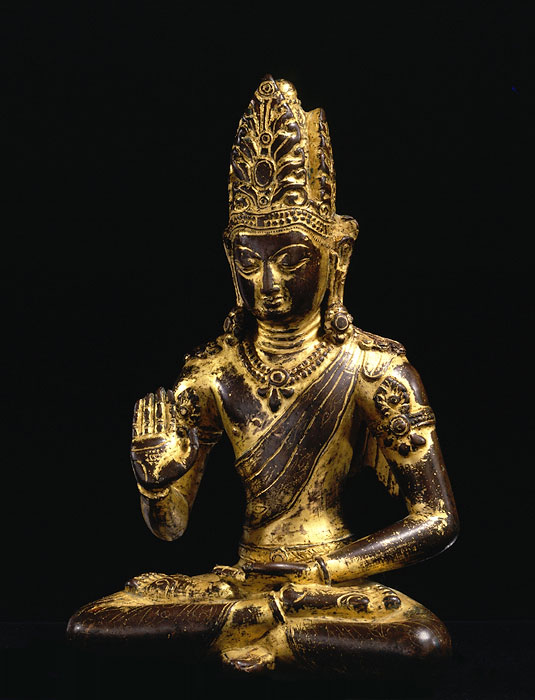previous image | Gallery 3: Tibet | next image

TIBET
12. Amogasiddhi
Tibet
c. 11th century
Gilt copper
H. 22.3 W. 15.2 D. 9.5
Collection J. and M. Meijer, The Netherlands
catalogue #43
The Tathagata, transcendent Buddha, is seated in vajraparyankasana with right hand raised in abhayamudra, the gesture of reassurance. It is this gesture that determines the identity of the crowned and bejewelled deity. Amogasiddhi is one of the five Tathagatas that were a notably popular sculptural theme in the early Chidar, the second diffusion of Buddhism in Tibet from the tenth century onwards.1 Nepalese artists were working in Tibet during this period, and their influence on Tibetan sculpture can be seen in this powerful image. The tall three-leaf crown type may be compared with sculpture from the Kathmandu Valley, although its proportions are exaggerated in this statue.2 The earrings, necklace, and armbands are similarly comparable.3 Comparisons may also be made with the tall three-leaf crowns of sculpture dating from around 1200 at Nyethang, just west of Lhasa.4 It is, however, the deviation from Kathmandu Valley style, for instance the exaggerated height of the crown, that indicates a Tibetan provenance. Another sculpture of very similar style, depicting Vajrahumkara, bears an inscription in Tibetan that confirms its origin and thereby that of the Amogasiddhi.5
1
For example the now destroyed eleventh-century sites of Runon and
Kyangbu; see von Schroeder, 2001, figs. XIII-11-21. |
all text & images © 2005 The authors, the photographers and the Ethnographic Museum, Antwerp
![]()
